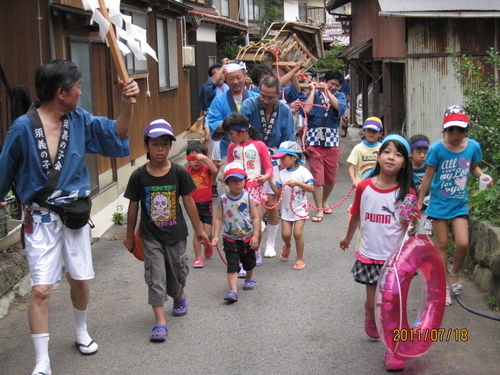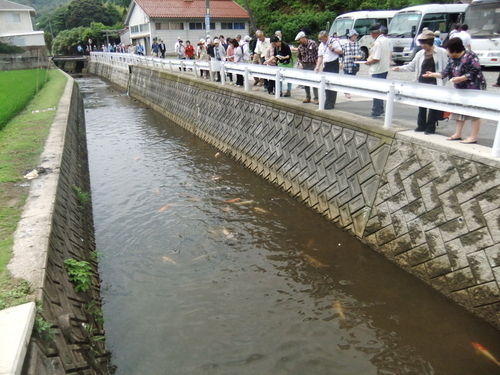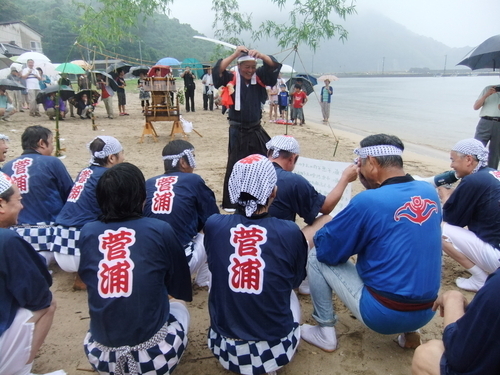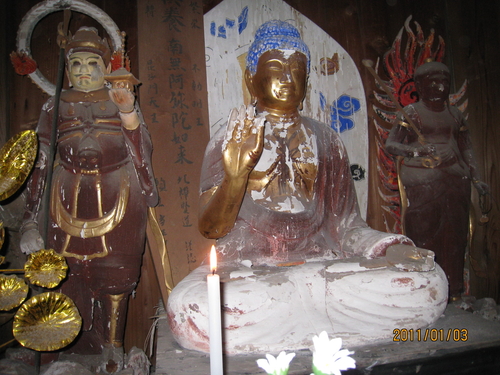Suge ura
| Bay Name | Suge-ura |
|---|---|
| Shrine Name | Shingu-jinja(Former) Sugi-jinja(Current) |
| Deity |
Sarutahiko Homutawake no mikoto |
| Location |
Matsue-shi Mihonoseki-cho Suge ura 289 |
Suge ura Shingu jinja
Moromoro no sawari kegare o imasara ni
Susuge urawa no kiyoki migiwa ni

First of all, to avoid any confusion, a word about the reading of the name ‘Suge ura’. While the bay name is read ‘Suge’, among the villagers, the shrine has long been pronounced ‘Sugi’ jinja.
Back in the Edo era when the 42 -bay pilgrimage was taking place, the bay was written with different characters pronounced probably ‘suke’, or ‘suge’. In the Fudoki, there is mention of a shrine and a beach written in characters usually pronounced ‘sugi’, but in the Tenpyo era document, “Izumo no kuni keikaicho’ , the same beach is written as ‘shige’ suggesting that this may be the original reading.
The ‘Suke ura’ from the pilgrimage days is today’s Suge ura, tying in with the ‘sugi’ beach from the Fudoki and further offering proof of the existence of the aforementioned shrine from the Fudoki.
The modern shrine in Suge ura, Sugi-jinja, enshrined near the community center, is likely a ‘descendant’ of the Suga yashiro listed in the Fudoki.
The next issue concerns the former shrine, ‘Shingu-jinja’. The Unyoushi publication in its section on Suge ura first refers to a Kamuhata myoujin shrine, but after that there is only mention of a ‘Shingu’. According to the 1875 document, ‘Teikoku chishi’ (Imperial Topgraphy), there were two shrines in Suge ura, Sugi-jinja and Shingu-jinja. The report says that Shingu-jinja is 800m south of the village, the enshrined deities are Izanagi-no-mikoto, Hayatama-no-ono kami and Kotosaka no ono mikoto. Sugi-jinja is 100m from the bay with the deities Sarutahiko and Homutawake no mikoto.
Present day Shingu-jinja is without any shrine precincts due to road construction and has ended up being enshrined together with Sugi-jinja.
At the start of the bay pilgrimage, Shingu-jinja, located in a mountainous region at a distance from the shore was a point of worship for pilgrims. It would appear that later, the object of worship was changed to a shrine closer to the beach. In his records of his visit, Kanezaki Zenbei noted the shrine name as, ‘Kamuhata-jinja’. That shrine is current day Sugi-jinja with eleven enshrined deities, three of which were originally from Shingu-jinja.

To get to Suge jinja, pass by Nagami jinja on the Matsue Mihonoseki line. Go left at the traffic lights at the T-junction in front of the Miho no seki sports park towards Kita ura. Further down that road, go in the direction of Shichirui and after going down a rather narrow road, you’ll arrive at the shrine.
Following the river a little more will take you to the open sea and the beautiful sands of the Sugi-hama (beach) bathing area. In the river in front of the shrine, you can see huge carp swimming by. These were first released into the river back in Showa 58 (1983), during the revitalization of the town under the leadership of the ‘Suginoko’ Organization.
The ‘Akugiri’ ritual where traditionally, a sword was used to slice and cure epidemics was resumed at the start of the Gion festival which begins in the middle of July at Sugihama beach. At the festival, o-mikoshi are paraded through the town by both children and adults and gather at the beach. The adults bearing o-mikoshi enter the sea and a purification ceremony is performed. In certain years, city officials, newlyweds and regular people can also undergo purification in the sea.
The Suginoko efforts are still continuing today and are based at the Fureai hall at the side of Sugi jinja.


| Bay Name | Suge-ura |
|---|---|
| Shrine Name | Shingu-jinja(Former) Sugi-jinja(Current) |
| Deity |
Sarutahiko Homutawake no mikoto |
| Location |
Matsue-shi Mihonoseki-cho Suge ura 289 |
Suge ura Shingu jinja
Moromoro no sawari kegare o imasara ni
Susuge urawa no kiyoki migiwa ni
First of all, to avoid any confusion, a word about the reading of the name ‘Suge ura’. While the bay name is read ‘Suge’, among the villagers, the shrine has long been pronounced ‘Sugi’ jinja.
Back in the Edo era when the 42 -bay pilgrimage was taking place, the bay was written with different characters pronounced probably ‘suke’, or ‘suge’. In the Fudoki, there is mention of a shrine and a beach written in characters usually pronounced ‘sugi’, but in the Tenpyo era document, “Izumo no kuni keikaicho’ , the same beach is written as ‘shige’ suggesting that this may be the original reading.
The ‘Suke ura’ from the pilgrimage days is today’s Suge ura, tying in with the ‘sugi’ beach from the Fudoki and further offering proof of the existence of the aforementioned shrine from the Fudoki.
The modern shrine in Suge ura, Sugi-jinja, enshrined near the community center, is likely a ‘descendant’ of the Suga yashiro listed in the Fudoki.
The next issue concerns the former shrine, ‘Shingu-jinja’. The Unyoushi publication in its section on Suge ura first refers to a Kamuhata myoujin shrine, but after that there is only mention of a ‘Shingu’. According to the 1875 document, ‘Teikoku chishi’ (Imperial Topgraphy), there were two shrines in Suge ura, Sugi-jinja and Shingu-jinja. The report says that Shingu-jinja is 800m south of the village, the enshrined deities are Izanagi-no-mikoto, Hayatama-no-ono kami and Kotosaka no ono mikoto. Sugi-jinja is 100m from the bay with the deities Sarutahiko and Homutawake no mikoto.
Present day Shingu-jinja is without any shrine precincts due to road construction and has ended up being enshrined together with Sugi-jinja.
At the start of the bay pilgrimage, Shingu-jinja, located in a mountainous region at a distance from the shore was a point of worship for pilgrims. It would appear that later, the object of worship was changed to a shrine closer to the beach. In his records of his visit, Kanezaki Zenbei noted the shrine name as, ‘Kamuhata-jinja’. That shrine is current day Sugi-jinja with eleven enshrined deities, three of which were originally from Shingu-jinja.
To get to Suge jinja, pass by Nagami jinja on the Matsue Mihonoseki line. Go left at the traffic lights at the T-junction in front of the Miho no seki sports park towards Kita ura. Further down that road, go in the direction of Shichirui and after going down a rather narrow road, you’ll arrive at the shrine.
Following the river a little more will take you to the open sea and the beautiful sands of the Sugi-hama (beach) bathing area. In the river in front of the shrine, you can see huge carp swimming by. These were first released into the river back in Showa 58 (1983), during the revitalization of the town under the leadership of the ‘Suginoko’ Organization.
The ‘Akugiri’ ritual where traditionally, a sword was used to slice and cure epidemics was resumed at the start of the Gion festival which begins in the middle of July at Sugihama beach. At the festival, o-mikoshi are paraded through the town by both children and adults and gather at the beach. The adults bearing o-mikoshi enter the sea and a purification ceremony is performed. In certain years, city officials, newlyweds and regular people can also undergo purification in the sea.
The Suginoko efforts are still continuing today and are based at the Fureai hall at the side of Sugi jinja.






